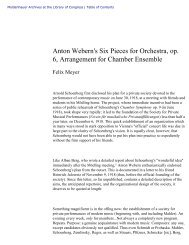Country Profile: Cuba - American Memory - Library of Congress
Country Profile: Cuba - American Memory - Library of Congress
Country Profile: Cuba - American Memory - Library of Congress
Create successful ePaper yourself
Turn your PDF publications into a flip-book with our unique Google optimized e-Paper software.
<strong>Library</strong> <strong>of</strong> <strong>Congress</strong> – Federal Research Division <strong>Country</strong> <strong>Pr<strong>of</strong>ile</strong>: <strong>Cuba</strong>, September 2006<br />
immigration talks with Havana that had been held biannually for a decade. In May 2004, he<br />
endorsed new proposals to reduce the amount <strong>of</strong> remittances émigrés can send back to <strong>Cuba</strong> and<br />
further restrict the number <strong>of</strong> visits <strong>Cuba</strong>ns living in the United States can make to their<br />
homeland. <strong>Cuba</strong> responded by cultivating closer relations with China and North Korea.<br />
Internal Political Developments: A crack opened in the <strong>Cuba</strong>n system in May 2002, when a<br />
petition with 11,000 signatures—part <strong>of</strong> an unusual dissident initiative known as the Varela<br />
Project—was submitted to the National Assembly <strong>of</strong> Popular Power (hereafter, National<br />
Assembly). Started by Oswaldo José Payá Sadinas, now <strong>Cuba</strong>’s most prominent dissident leader,<br />
the Varela Project called for a referendum on basic civil and political liberties and a new<br />
electoral law. In the following month, however, the government responded by initiating a drive<br />
to mobilize popular support for an amendment to the constitution, subsequently adopted<br />
unanimously by the National Assembly, declaring the socialist system to be “untouchable,”<br />
permanent, and “irrevocable.”<br />
In recent years, <strong>Cuba</strong>n politics have been dominated by a government campaign targeting<br />
negative characteristics <strong>of</strong> the socialist system, such as “indiscipline” (for example, theft <strong>of</strong><br />
public and private property, absenteeism, and delinquency), corruption, and negligence. Under<br />
the campaign, unspecified indiscipline-related charges were brought against a member <strong>of</strong> the<br />
<strong>Cuba</strong>n Communist Party and its Political Bureau, resulting in his dismissal from these positions<br />
in April 2006.<br />
One <strong>of</strong> the world’s last unyielding communist bulwarks, Castro, hospitalized by an illness,<br />
transferred power provisionally to his brother, General Raúl Castro Ruz, first vice president <strong>of</strong><br />
the Council <strong>of</strong> State and Council <strong>of</strong> Ministers and minister <strong>of</strong> the Revolutionary Armed Forces<br />
on July 31, 2006. Fidel Castro’s unprecedented transfer <strong>of</strong> power and his prolonged recovery<br />
appeared to augur the end <strong>of</strong> the Castro era.<br />
GEOGRAPHY<br />
Location: <strong>Cuba</strong> is located between the Caribbean Sea and the<br />
North Atlantic Ocean. It is the westernmost island <strong>of</strong> the Greater<br />
Antilles and the largest country in the Caribbean. Its nearest<br />
Caribbean neighbors, listed clockwise, are The Bahamas, Haiti<br />
Click to Enlarge Image<br />
(separated from <strong>Cuba</strong> by the Windward Passage), Jamaica, and<br />
the Cayman Islands. <strong>Cuba</strong> is separated from the southern tip <strong>of</strong><br />
Florida by the Strait <strong>of</strong> Florida and from the easternmost tip <strong>of</strong> Mexico by the Yucatan Channel.<br />
Size: <strong>Cuba</strong> is slightly smaller than Pennsylvania. Its land area is 110,860 square kilometers,<br />
including Isla de <strong>Cuba</strong> (104,945 square kilometers), Isla de la Juventud (2,200 square<br />
kilometers), and adjacent keys (3,715 square kilometers). The island extends about 1,225<br />
kilometers from Cabo de San Antonio to Cabo Mais, the western and eastern extremities,<br />
respectively. The average width is about 80 kilometers, with extremes ranging from 35 to 251<br />
kilometers.<br />
5



![Albert Einstein Papers [finding aid]. Library of Congress. [PDF ...](https://img.yumpu.com/21604228/1/190x245/albert-einstein-papers-finding-aid-library-of-congress-pdf-.jpg?quality=85)





![American Colony in Jerusalem Collection [finding aid]. Library of ...](https://img.yumpu.com/17941275/1/190x245/american-colony-in-jerusalem-collection-finding-aid-library-of-.jpg?quality=85)



![Piccard Family Papers [finding aid]. - American Memory - Library of ...](https://img.yumpu.com/17941234/1/190x245/piccard-family-papers-finding-aid-american-memory-library-of-.jpg?quality=85)


